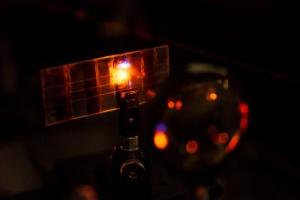Mar 26 2014
In future, when your mobile or tablet runs out of battery, you could just recharge it by putting it out in the sun.
 This image shows NTU's new Perovskite solar cell as seen in the lab, which was found have light emitting properties. Credit: Nanyang Technological University
This image shows NTU's new Perovskite solar cell as seen in the lab, which was found have light emitting properties. Credit: Nanyang Technological University
Nanyang Technological University (NTU) scientists have developed a next-generation solar cell material which can also emit light, in addition to converting light to electricity.
This solar cell is developed from Perovskite, a promising material that could hold the key to creating high-efficiency, inexpensive solar cells. The new cells not only glow when electricity passes through them, but they can also be customised to emit different colours.
Picture this: A shopping mall facade could be storing solar energy in the day and transforms into a light display for advertisements that glows at night.
This discovery, published in top academic journal Nature Materials, was discovered almost by chance when NTU physicist Sum Tze Chien, asked his postdoctoral researcher Xing Guichuan to shine a laser on the new hybrid Perovskite solar cell material they are developing.
Assistant Professor Sum said to the team's surprise, the new Perovskite solar cell glowed brightly when a laser beam was shone on it. This is a significant finding as most solar cell materials are good at absorbing light but are generally not expected to generate light. In fact, this highly luminescent new Perovskite material is also very suitable for the making of lasers.
"What we have discovered is that because it is a high quality material, and very durable under light exposure, it can capture light particles and convert them to electricity, or vice versa," said Asst Prof Sum, a Singaporean scientist at NTU's School of Physical and Mathematical Sciences (SPMS).
"By tuning the composition of the material, we can make it emit a wide range of colours, which also makes it suitable as a light emitting device, such as flat screen displays."
His research partner, Assistant Professor Nripan Mathews from the School of Materials Science and Engineering (MSE) and the Energy Research Institute @ NTU (ERI@N), said this newly discovered property is expected to enable the industry to feasibly adopt the material for use into existing technology.
"What we have now is a solar cell material that can be made semi-translucent. It can be used as tinted glass to replace current windows, yet it is able to generate electricity from sunlight.
"The fact that it can also emit light makes it useful as light decorations or displays for the facades of shopping malls and offices," said Dr Mathews, who is also the Singapore R&D Director of the Singapore-Berkeley Research Initiative for Sustainable Energy (SinBeRISE) NRF CREATE program.
"Such a versatile yet low-cost material would be a boon for green buildings. Since we are already working on the scaling up of these materials for large-scale solar cells, it is pretty straightforward to modify the procedures to fabricate light emitting devices as well. More significantly, the ability of this material to lase, has implications for on-chip electronic devices that source, detect and control light," he added.
This NTU breakthrough has already won praise from experts. Professor Ramamoorthy Ramesh, the Purnendu Chatterjee Endowed Chair in Energy Technologies professor at the University of California, Berkeley in the United States said: "This work from the NTU SinBeRISE team clearly shows the promise of such new materials in a broad range of applications, including solar cells and now for lasing. It also shows the power of interdisciplinary, basic science in making fundamental discoveries that will impact in a broad sense."
Professor Ramesh, an award-winning scientist highly regarded worldwide by both academia and industry, has over two decades of experience leading world-class research in the areas of electronics and solar materials.
The inner workings of the new NTU solar cell material were published in the world's top scientific journal, Science, in October last year by the same NTU research group.
The advanced material, which is currently patent pending, is five times cheaper than current Silicon-based solar cells. This is due to its easy solution-based manufacturing process, which works by combining two or more chemicals at room temperature.